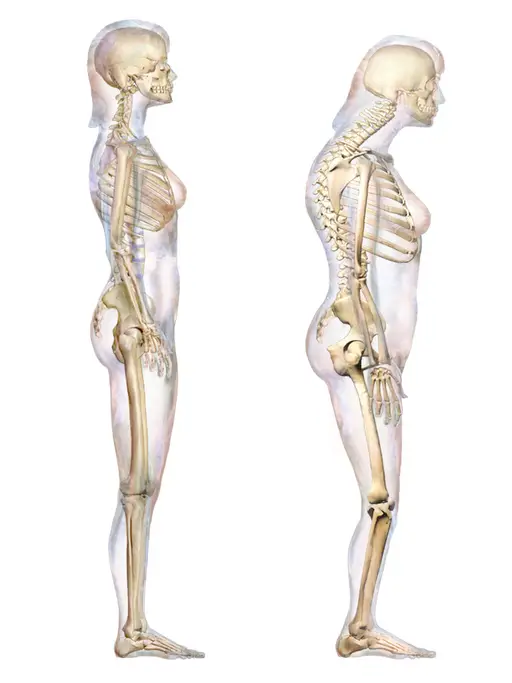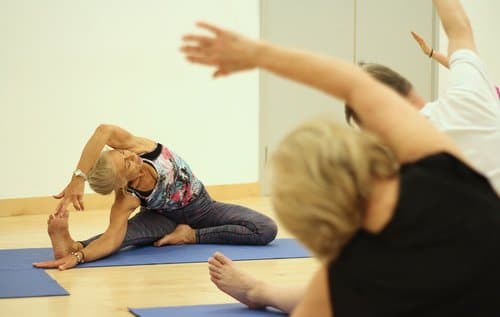It is common to see elderly people stooped or hunched over. But if we take precautions early, it is possible to prevent stooping as we age. In this article, we examine what are the causes of and how to prevent stooping in old age.
Contents
What Causes Stooping in Old Age?
There are many different causes of stooping. Some are easier to combat than others. The most common cause is general arthritis and degeneration of discs. Sometimes this is called Degenerative Disc Disease.
The “Disease” part can scare some people but it is really not the type of “Disease” you’re thinking of. Realistically it’s another word for more significant arthritis.
Osteoporosis can also cause the vertebrae to become weaker and slowly shrink leading to a decrease in height which causes a rounded back. In some cases, osteoporosis can lead to compression fractures of the vertebrae which can decrease their height even more.
Most times stooping is caused by weaker postural muscles. In our society, we spend a lot of time sitting at a desk on our computers or watching TV. This leads us to constantly using the muscles in the front of our body and never exercising or strengthening the muscles in the back of our body.
This leads to our chest being tight and the back becoming weak which can lead us to stoop because it is a more comfortable position.

How to Prevent Stooping in Old Age?
The best way to prevent stooping in old age is to stay active. Staying active will move your joints and prevent them from staying in one position for too long, which is usually the cause of preventative stooping.
When we stay in one position for too long, which is usually a flexed forward position, our joints get restricted and “locked” into that position. This usually causes are shoulder to round forward and our head to lean forward also. This gives the overall appearance of a rounded back and hunching forward.
Staying active and stretching the front of your shoulders and chest will help release the tension in the front of your body allowing your spine to straighten up. It is also beneficial to strengthen your back muscles along the spine. This will allow those muscles to help keep your up and straight. We tend to forget about those muscles because we rarely need to use them.
You may also like Isometric Exercises for Osteoporosis
How Do You Correct Posture in the Elderly?
Correcting posture for some can be as easy as staying active and exercising. For others, they may need more detailed exercises to target specific muscles. The best way to know which exercises are best suited to you would be to get an assessment done by a movement professional such as a chiropractor or a physiotherapist.

When trying to correct posture the main goal is to strengthen the postural muscles of the spine and relaxing or stretching the muscles in the front of the body. This allows the balance between the two to become more even which makes sustaining proper posture easier.
For females especially, making sure to get adequate calcium and vitamin D in order to maintain bone density can help. These supplements can slow the onset of osteoporosis which can reduce the height of your vertebrae.
Can a Hunched Back Be Straightened?
This really depends on what is causing the hunched back. If it is just due to weaker postural muscles than it can definitely be worked on. If it’s a result of compression fractures then it will be more difficult but exercises and rehabilitation can still help some individuals.
It is important to know the cause of your hunching as every person is different. Seeing someone who is qualified to assess you will put you on the proper path of combating the hunched back and will result in better outcomes. Every person is different and everyone responds differently to certain exercises and treatment plans.
Some individuals may find that, depending on their condition, their posture isn’t improving significantly but maybe their pain levels are decreasing or mobility is increasing. It is important to look at the overall picture such as quality of life and not just posture when helping someone.
You may also like Best Exercises for Bone Health
Is It Too Late to Fix My Posture?
It is never too late to try and improve your posture. Obviously, the quicker you start the better it will be for you. But doing something is better than not doing anything. The best time to start is always today.
What Can I Use a Posture Corrector For?
Posture correctors have recently become popular. They do help improve your posture by bringing your shoulder back resulting in you standing or sitting a little straighter. This goes back to how I previously mentioned that posture is all about the balance between the front muscles and back muscles.

The only issue with these types of correctors is that they rely on a passive mechanism. This means your body isn’t actually using the muscles needed to stay upright and have a better posture, it’s just relying on this corrector to do the work for you. This usually means that once you take it off you’re back to square one.
If you want more of a permanent fix then strengthening your postural muscles is the best thing you can do. That way they are strong and constantly working and you’re not just relying on the corrector.
The correctors can still be beneficial to wear in the beginning stages of bettering your posture. The important thing is to not rely on the corrector and actually attempt to strengthen your postural muscles. Once you become stronger you can slowly phase out the corrector and one day you’ll notice you won’t even need it.
Here we have a video on how to wear a posture corrector.
You may also like Best Chair Exercises for Seniors
Conclusion
People tend to stoop as they age but this condition can definitely be worked on and helped. Like with many conditions, proper exercise is the first step. To know the kind of exercise best in your condition, it is ideal that you speak to a chiropractor or a physiotherapist. Another option is to use a posture corrector to help you get the right posture. If timely action is taken, it is possible to avoid or lessen stooping in old age.
If you are looking for more information on the health of your back, you can read our articles about the heating pads for sciatica, how to sleep with lower back pain, and vacuum cleaners for those with a bad back.
